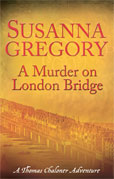 Thomas Chaloner’s Fifth Exploit in Restoration London
Thomas Chaloner’s Fifth Exploit in Restoration London
Thomas Chaloner has forged a living as a spy for the Earl of Clarendon since the early days of the Restoration, but are they about to come to an abrupt and perhaps fatal end?
In February 1664, Chaloner is aware of an undercurrent on the streets of London. The coffee houses are thick with rumours; there is anger at the new laws governing church attendance; and Londoners are viewing with ever deeper contempt the debauchery of the King and his courtiers. And there is murder.
The infamous church-smasher Dick Culmer is killed among the ramshackle buildings of London Bridge, and Chaloner’s investigations link Culmer to a group of Puritan conspirators. Meanwhile, in the Palace of White Hall, Chaloner realises that the ring-leaders of a rebellion are planning an explosive climax to achieve their goals. Desperately racing against time, Chaloner is determined to thwart them – as determined as they are to prevent him from revealing their true intentions…
[buyingbuttons3 amazonpaperback=”http://www.amazon.co.uk/Murder-London-Bridge-Chaloners-Restoration/dp/0751541826/ref=tmm_pap_title_0?ie=UTF8&qid=1341405969&sr=1-1″ amazonhardback=”http://www.amazon.co.uk/Murder-London-Bridge-Chaloners-Restoration/dp/1847442528/ref=sr_1_1_title_0_main?s=books&ie=UTF8&qid=1341405969&sr=1-1″ kindle=”http://www.amazon.co.uk/Murder-London-Bridge-Restoration-ebook/dp/B004JHY8Z8/ref=tmm_kin_title_0?ie=UTF8&m=A3TVV12T0I6NSM&qid=1341405969&sr=1-1″ waterstones=”http://www.waterstones.com/waterstonesweb/products/susanna+gregory/a+murder+on+london+bridge/7441370/” ebook=”http://www.waterstones.com/waterstonesweb/products/susanna+gregory/a+murder+on+london+bridge+28ebook29/8402765/” amazonuspaper=”http://www.amazon.com/Murder-London-Bridge-Chaloner-Mysteries/dp/0751541826/ref=sr_1_1?ie=UTF8&qid=1341405680&sr=8-1&keywords=murder+on+london+bridge+gregory” amazonushard=”http://www.amazon.com/Murder-London-Bridge-Chaloner-Mysteries/dp/1847442528/ref=tmm_hrd_title_0?ie=UTF8&qid=1341405680&sr=8-1″ kindleus=”http://www.amazon.com/Murder-London-Bridge-Restoration-ebook/dp/B004JHY8Z8/ref=sr_1_2?ie=UTF8&qid=1341405774&sr=8-2&keywords=murder+on+london+bridge+gregory” ]
A Murder on London Bridge is also available as a Soundings Audio Book, read by Gordon Griffin. It can be ordered as either CD or cassette or downloaded from iTunes.
Extract
London Bridge, late January 1664
The Earl of Clarendon hated the London Bridge. He disliked the way its narrow-fronted, teetering houses loomed over the road, meeting overhead to turn it into a shadowy, sinister tunnel. And he disliked the fact that it was always so busy – thick with carts, people and animals. Usually, he hired a boat if business took him south of the river, but a spate of abnormally high tides meant they were not currently available – so he had had no choice but to brave the Bridge.
He sat in his fine coach and glowered out of the window, furious that no oarsman had been free to ferry him across the churning brown waters. Then he remembered the last time it had happened. It had been a few days before, and he had been somewhat startled to see several of his enemies loitering around one of the Bridge’s rickety houses. Moreover, he had also been told that dubious characters had taken to lurking there – men such as the infamous iconoclast ‘Blue Dick’ Culmer.
And if that were not enough to raise eyebrows, there were the Bridge’s two wardens. The Earl did not trust them at all, mostly because they were rumoured to be incorruptible. Who was incorruptible in Restoration London, where only the devious and dishonest could expect to prosper? As far as the Earl was concerned, anyone extolled as men of honour automatically earned his suspicion!
He narrowed his eyes as he passed Chapel House, a shabby affair that had been built on the site of a church dedicated to St Thomas Becket. It was swathed in scaffolding and canvas, because someone had decided it needed refurbishing, which effectively shielded it from passers-by. But the material was poorly secured, and through a gap, the Earl glimpsed a gaggle of his enemies’ servants. They were huddled together, speaking in low voices.
He experienced a surge of unease. What were they doing? Hatching another plot against him? After twenty years of civil war and military dictatorship, England was an unstable, restless country, full of shifting loyalties. Uprisings occurred on a weekly basis, and no government minister who valued his life and his position ignored that fact. It was not impossible that his foes were planning some sort of coup that would see him discredited – or worse.
The carriage rattled on, passing Nonesuch House, a fabulous jumble of onion domes and great glass windows, currently rented by a fellow named Sir John Winter. The Earl pursed his lips. Not only was Winter a Catholic, but he was reputed to be an authority on gunpowder, too. And if that combination was not sinister, then the Earl did not know what was. He would have ordered Winter put under surveillance, but the only man he trusted to do it – Thomas Chaloner – was in Wimbledon on other duties. Still, Chaloner would be back soon, and then he could look into whatever dark business was fermenting on the Bridge.
Finally, the coach reached the Stone Gate, where the Earl’s eyes were drawn upwards, to the severed heads that had been impaled on spikes above the arch – traitors, all executed since the monarchy had been restored three years before. Some were men the King would have spared, but the Earl had urged him against clemency, lest it was seen as a sign of weakness. He felt no remorse, though, as he stared at the blackened, unrecognisable features. It was hardly his fault they had backed the wrong side.
As his carriage passed under the arch, there was a sudden violent thud that made him jump and set his heart racing. Immediately, people started to shout, then laugh. It did not take the Earl long to realise what had happened. One of the heads had come off its pike, and landed on the roof of his coach. The vile things dropped not infrequently, especially during windy weather, but the Earl was seized by the immediate and unshakable sense that it was an omen of evil to come.
He could not prevent a shudder as the head was brandished outside his window by a grinning apprentice. He told himself he was being fanciful – that the falling skull was a chance event, and meant nothing at all. But his stomach continued to roil, and gradually he accepted what he knew to be true, deep in his heart – it was an omen, and it boded ill for him, for the people who knew him, and for London.

